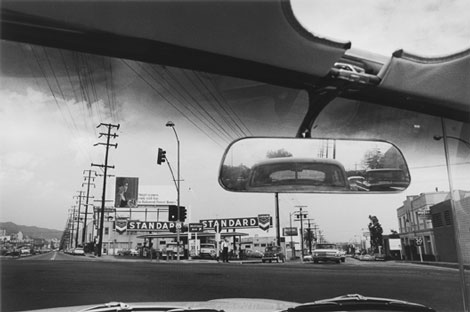The image of “the road” is one of the metaphors most deeply embedded in the American cultural landscape, perhaps most poignantly for the inter-war generation that produced both Dennis Hopper (born 1936) and Jack Kerouac (born 1922) among so many others.
Beginning in the early 1960s, Dennis Hopper produced a rich body of photographic work that has garnered ongoing critical and scholarly attention, along with the attendant gallery and museum exposure (for a listing of exhibitions beginning with his first solo show in 1961, see Hopper’s website dennishopper.com; his most recent gallery show [of the so-called Lost Album] was at Gagosian NYC in 2013).
Although Hopper’s photographic oeuvre is quite diverse, its historical ground zero could well be at the intersection of Santa Monica Boulevard and Melrose Avenue in West Hollywood, the virtually unrecognizable site of his brilliant 1961 Double Standard. This seemingly off-hand shot, which might easily pass as someone else’s anonymous and slightly off kilter snap, in fact captures an image of the American road that is both historically fraught and formally complex.
Although they run parallel across much of Los Angeles, Santa Monica and Melrose eventually do meet at the acute angle we see in Hopper’s photo, apparently taken from inside a car as it glides into the intersection. This POV establishes a clever two-point perspective (follow the power poles) that pivots on the light stanchion to the left of center. However, this erstwhile Renaissance system is perfectly disguised by the unplanned snapshot quality of the entire image—note, for example, the intrusive bit of hood that disrupts the bottom of the frame.
As we look out onto the intersection, we are thus presented with a kind of choice (Santa Monica or Melrose) embedded in the structure of the image, although we are given little help in making it: one street, one road is more-or-less the same as any other. The focus of visual attention is the Standard Oil station, its two signs providing the punning substance of the title. However, attention is also drawn by the reflection in the rearview mirror and the patch of sky in the upper right along a path that effectively flattens the visual field, negating the double plunge into perspectival depth.
What we see, then, is an image of quasi-minimal visual interest (an “as-if” amateur snapshot) that masks an inversion of the traditional metaphor of the road as a path into a space of unlimited personal freedom. Rather, the intersection has become the site of an essentially meaningless choice, while our progress forward is always dogged by a reflected image of what’s been left behind.
Historically, the photo also provides an adumbration both of Ed Ruscha’s 1963 artist’s book, Twentysix Gas Stations, and in his own signature set of variations on the oil on canvas Standard Station, Amarillo, Texas (also 1963). In addition, it looks forward, both in subject matter and in process, to the strategies developed a decade later by Robert Venturi and Denise Scott Brown for use in recording and theorizing America’s vernacular landscape in the landmark project, Learning from Las Vegas. Not bad for a mere “beginner.”


